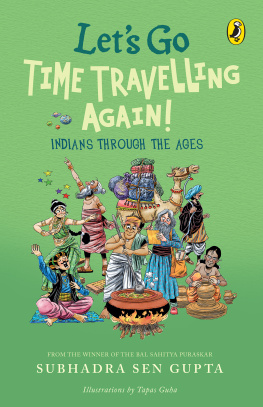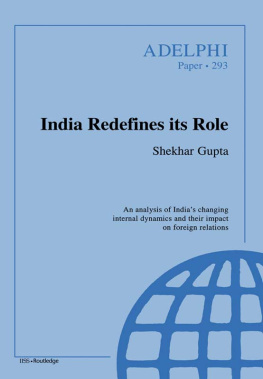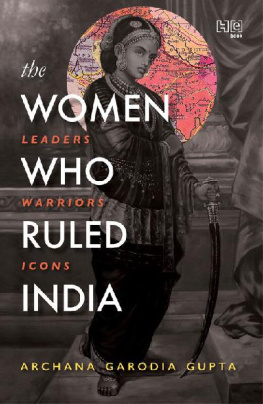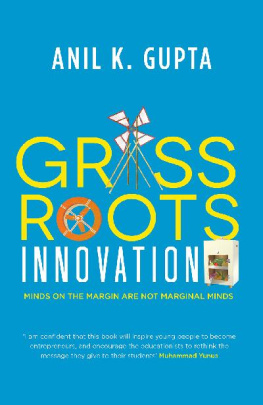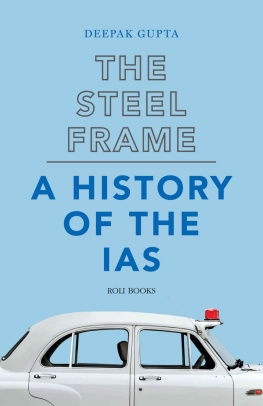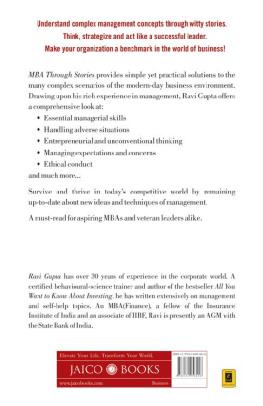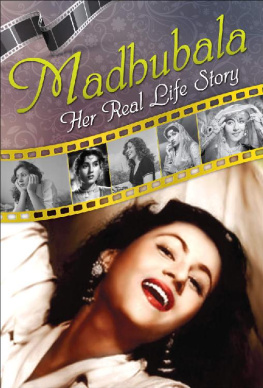Subhadra Sen Gupta - A Children’s History of India
Here you can read online Subhadra Sen Gupta - A Children’s History of India full text of the book (entire story) in english for free. Download pdf and epub, get meaning, cover and reviews about this ebook. year: 2015, publisher: Rupa/Red Turtle Publ., genre: Religion. Description of the work, (preface) as well as reviews are available. Best literature library LitArk.com created for fans of good reading and offers a wide selection of genres:
Romance novel
Science fiction
Adventure
Detective
Science
History
Home and family
Prose
Art
Politics
Computer
Non-fiction
Religion
Business
Children
Humor
Choose a favorite category and find really read worthwhile books. Enjoy immersion in the world of imagination, feel the emotions of the characters or learn something new for yourself, make an fascinating discovery.
- Book:A Children’s History of India
- Author:
- Publisher:Rupa/Red Turtle Publ.
- Genre:
- Year:2015
- Rating:3 / 5
- Favourites:Add to favourites
- Your mark:
- 60
- 1
- 2
- 3
- 4
- 5
A Children’s History of India: summary, description and annotation
We offer to read an annotation, description, summary or preface (depends on what the author of the book "A Children’s History of India" wrote himself). If you haven't found the necessary information about the book — write in the comments, we will try to find it.
A Children’s History of India — read online for free the complete book (whole text) full work
Below is the text of the book, divided by pages. System saving the place of the last page read, allows you to conveniently read the book "A Children’s History of India" online for free, without having to search again every time where you left off. Put a bookmark, and you can go to the page where you finished reading at any time.
Font size:
Interval:
Bookmark:
A CHILDREN'S HISTORY OF INDIA
SUBHADRA SEN GUPTA has written over thirty books for children including mysteries, adventures, ghost stories, comic books and books on history. To her surprise, the Bal Sahitya Akademi thinks she is doing a good job and has given her the Bal Sahitya Puraskar in 2014. Right now she is waiting for a time machine so that she can travel to the past and join Emperor Akbar for lunch. She loves to travel, flirt with cats and chat with auto-rickshaw drivers. If you want to discuss anything under the sun with her, email her at .
PRIYANKAR GUPTA graduated from the National Institute of Design, specializing in animation film design. He has worked with various publishing companies across the world as an illustrator for childrens/YA books.

Published in Red Turtle by
Rupa Publications India Pvt. Ltd 2015
7/16, Ansari Road, Daryaganj
New Delhi 110002
Copyright Subhadra Sen Gupta 2015
Illustrations copyright Rupa Publications 2015
The views and opinions expressed in this book are the authors own and the facts are as reported by her which have been verified to the extent possible, and the publishers are not in any way liable for the same.
All rights reserved.
No part of this publication may be reproduced, transmitted, or stored in a retrieval system, in any form or by any means, electronic, mechanical, photocopying, recording or otherwise, without the prior permission of the publisher.
ISBN: 978-81-291-3490-5
First impression 2015
10 9 8 7 6 5 4 3 2 1
The moral right of the author has been asserted.
This book is sold subject to the condition that it shall not, by way of trade or otherwise, be lent, resold, hired out, or otherwise circulated, without the publishers prior consent, in any form of binding or cover other than that in which it is published.
This book is a small offering to all the teachers who made history come alive and made me fall in love with the subject. Most of all, it is for Dr Narayani Gupta, teacher, mentor and friend.
And for my friend, Natasha Raina Kanwar, who is forever waiting for a magnum opus.
CONTENTS
Section One
ANCIENT INDIA
(2600 BCE1200 CE)
A LAND CALLED JAMBUDVIPA
~ The Landscape ~ The Monsoons ~ Discovering the Past ~ Time before History ~
In the beginning, they called the land Jambudvipa, the land of the rose apple. A land of plenty, with the soaring snowcapped mountain ranges of the Himalayas in the north and the tumultuous waters of the Indian Ocean in the south. A land covered by a network of ever-flowing rivers, bringing the promise of fertile soil, and generous harvests. The wave-lashed coastal regions of the peninsula encouraged adventure and trade and the forests were filled with the bounties of nature. It was a land that welcomed people, encouraged them to weave cloth and mould pottery, to dance and sing, to experiment with spices and live off the soil.
This generous land would one day be named India, after a river, the Indus. And from the time of the Aryans, we call our country Bharatvarsha, after an Aryan tribe, the Bharatas. However, its earliest inhabitants named it after a fruitthe jambuthe rose apple or jamun. So since ancient times, India was Jambudvipa, or the island of the rose apple.

The Indian subcontinent. The land once called Jambudvipa. Today, we call it India and Bharat.
The Landscape
India is so big that it has every kind of landscape imaginablemountains, plains, deserts, plateaus, deltas and coasts. Its climate ranges from the icy winters of Ladakh to the tropical summers of Kerala. And all these geographical features have played an important part in our history.
Lets first study the physical map of modern India. The Himalayan mountain range stands like a snowy crown in the north, separating India from the rest of Asia. This range, an immense 2,400 kilometres long, has several romantic names steeped in history and legendKarakoram, Hindu Kush, Pir Panjaland peaks like the Everest, the Annapurna and the Kangchenjunga. During ancient times, when invading armies moved only by land, these mountains acted like the ramparts of a fortress, discouraging attacks and allowing India to live in comparative peace. Of course, there were mountain passes like the Khyber and the Bolan in the north-west; these were mostly used by traders to take our goods as far as Europe but they also let in invadersfrom Alexander in the third century BCE to Babur in the sixteenth century.
Rivers are at the heart of our civilization. The Himalayas are the source of three mighty riversthe Indus, the Ganga and the Brahmaputra, that have spread their network through tributaries across the land from Punjab to Assam. The Indus flows out of Tibet, curves south into north India and then flows into the Arabian Sea in todays Pakistan. The Ganga rises in a glacial cave in Uttarakhand and then moves east towards the Bay of Bengal, creating one of the worlds biggest and most fertile alluvial plains. The Indo-Gangetic plain is at the heart of Indias civilization and has seen some of the most important events in our historyfrom the Buddha standing at its banks in Varanasi to the rise and fall of the famous city of Pataliputra.

The ice-capped mountain ranges of the mighty Himalayas.
The mighty Brahmaputra also starts its journey in Tibet but turns east and flows through Arunachal Pradesh and Assam, only to turn west into modern Bangladesh, where it meets the Padma, a tributary of the Ganga. Here, the many streams of the Ganga and Brahmaputra flow into the Bay of Bengal, creating a delta criss-crossed by streams that has been coveted over centuries by different invaders for its fertile soil.
Similarly, in the south, the great kingdoms rose and fell by the rivers, like the fabulous city of Vijayanagar that stood by the Tungabhadra. The Narmada and the Godavari brought life to central India; and the rice, spice and cotton fields of the Deccan were fed by the waters of the Krishna and the Kaveri. Cotton was grown and then woven into brightly coloured fabrics that were loaded on to ships that voyaged to Arabia and Mozambique, Java and Bali. Along with items of trade, traders carried with them the rich heritage of our culture.
The many ports along the western and eastern coasts, like Kaveripattinam, Bharuch and Kochi, saw many Arab, Malay and Chinese traders. Soon enough, the cotton and spices that we were famous for brought the Portuguese, the French and the English to our shores. They were not interested in peaceful trade but came to destroy, conquer and colonize the country and changed Indias history forever.
Indians and Geography

The ancient Indians were never very keen to draw accurate maps. In the Puranas, they described the world as a flat disc with a mythical mountain called Meru at the centre, surrounded by seas and seven islands or dvipas. These seas were said to be made not just of water but also milk, treacle, butter and ghee!
The Monsoons
Another mighty force of history races across the sky in the form of rain-laden clouds. The monsoon winds rise up in the Indian Ocean during summer and then, like clockwork, they move north, up the Indian landmass, bringing rain. One branch comes up from the Arabian Sea, the other from the Bay of Bengal and as they collide with the Himalayas, they pour their life-giving rain all across the land. They water the wheat fields of Punjab, the paddy fields of Bengal and the forests of Madhya Pradesh. By autumn, the same winds move in the opposite direction, raining on Tamil Nadu and Kerala.
Next pageFont size:
Interval:
Bookmark:
Similar books «A Children’s History of India»
Look at similar books to A Children’s History of India. We have selected literature similar in name and meaning in the hope of providing readers with more options to find new, interesting, not yet read works.
Discussion, reviews of the book A Children’s History of India and just readers' own opinions. Leave your comments, write what you think about the work, its meaning or the main characters. Specify what exactly you liked and what you didn't like, and why you think so.


